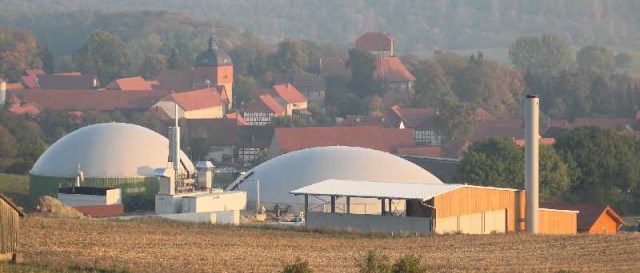German renewables organization AEE has published the update of its pie chart of ownership for 2012. Craig Morris explains what the different categories are.

Bioenergyvillage Juehnde, one of thousand examples of communal energy cooperatives throughout Germany. (Photo: Bioenergiedorf Jühnde)
The AEE has released the figures for ownership of renewables in 2012. The chart we used with data from 2011 (see our graph on ownership of renewables in Germany) was one of the most popular on our website, but also one that raised a lot of questions. For instance, how should “project firms” to be categorized?
Before we talk about category definitions, let’s compare the two charts (the one for 2012 is available in German here):
| 2011 | 2012 | Change | |
| Private citizens | 40 | 35 | -5 |
| Farmers | 11 | 11 | 0 |
| Big Four | 6.5 | 5 | -1.5 |
| Other energy suppliers | 7 | 7 | 0 |
| Funds/banks | 11 | 13 | 2 |
| Project firms | 14 | 14 | 0 |
| Industry | 9 | 14 | 5 |
| Other | 1.5 | 1 | -0.5 |
In four of the eight categories, there has been little or no change. Interestingly, investments made by Germany’s four largest utilities (Big Four) dropped considerably last year – so much for the idea (PDF) that these are the companies are “meant to invest in renewables.” They make up 75 percent of power production in Germany but only five percent of investments in renewables. But the biggest difference seems to be a shift from “private citizens” to “industry” – what’s going on there?
Here, I refer you to a definition of the terms in this PDF (in German) for the statistics from 2011. The Big Four are easy: EnBW, Eon, RWE, and Vattenfall. “Other energy suppliers” are the other energy firms, many of which are municipals excited about renewables.
Private citizens and farmers are also easy to define, with the distinction being important because of the large roofs and land area that farmers have (and the average citizen does not). Farmers can thus have far larger solar roofs than the average citizen, and they can also harvest energy crops, run biogas units from farm waste and energy crops, and have wind turbines installed on their land.
The category of funds & banks is a bit trickier. Obviously, banks finance a lot of the projects, but the figures above concern ownership – when banks keep projects in their own portfolio. On the other hand, funds are sold to individual investors, so some of this category will also include small businesses and individual citizens.
“Project firms” are generally developers who sell turnkey projects to other investors, but the figures above represent the projects that remain in the firm’s portfolio. The PDF mentions the examples of Enercon (Germany’s largest wind turbine manufacturer) and wpd, a well-known wind farm developer.
This brings us to the category of “industry.” The PDF explains that German term “Gewerbe” is used to mean production businesses from industry all the way down to tradespeople. We are currently updating the entire website with data for 2012, so this category label will be changed from “industry” to “commercial.” In my next post, I will discuss the apparent shift from private citizens to the commercial sector.
Craig Morris (@PPchef) is the lead author of German Energy Transition. He directs Petite Planète and writes every workday for Renewables International.
[…] the energiewende blog +++ 21.05.13 The commercial sector discovers "own consumption" +++ 15.05.13 German renewables still ground-roots movement […]
[…] Bringt man die Energiewende in Bürgerhand, dann entsteht auch kein Problem, wenn es keinen Erzeugungsvorrang gibt. Erst wenn es Anbieter gibt, die sowohl Erneuerbare Energieträger, als auch konventionelle/thermische Kraftwerke haben, bedarf es einer Lösung. Energieblogger Craig Morris hatte bereits im Mai die Eigentümerstruktur der Anlagen von 2011 und 2012 in einem Beitrag verglichen. […]
[…] owned by distant shareholders, a big chunk of the new renewable energy facilities we require can be locally owned by the communities they serve, or small to medium businesses, because the economies of scale for renewables are significantly […]
[…] 2011, more than half of investments in [German] renewables had been made by small investors. The switch to renewables […]
This is a fantastic website. My only complaint is that it is not updated to include 2013 data.